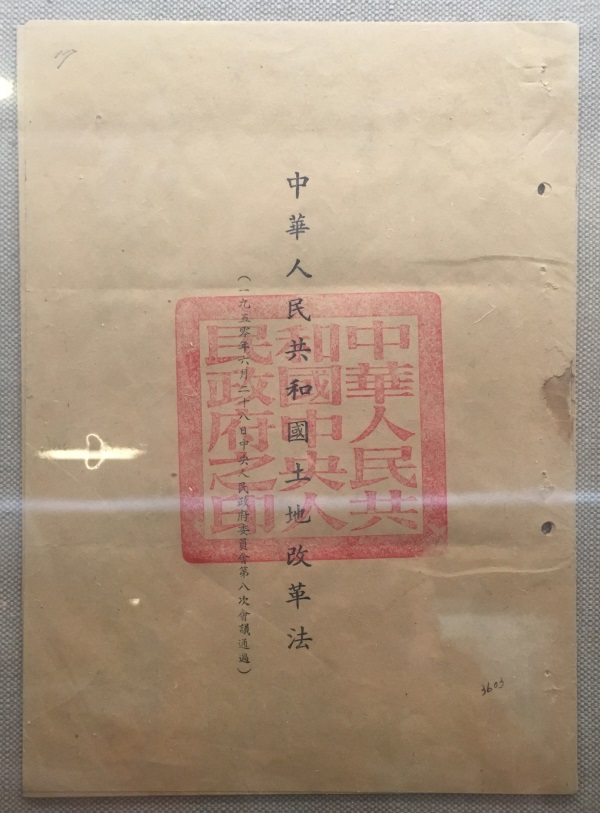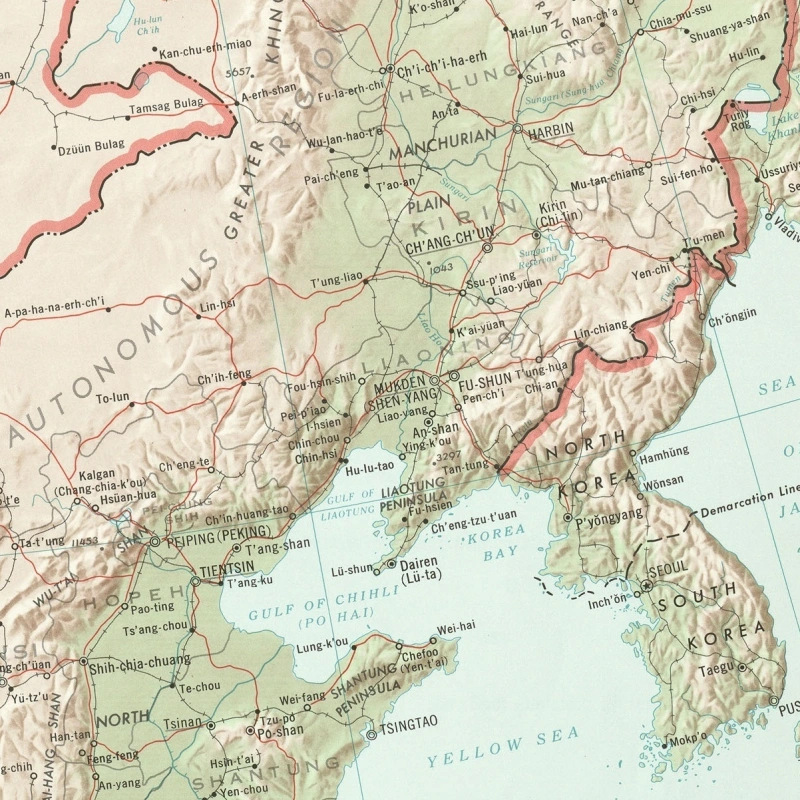Walking through the Road of Rejuvenation, the permanent exhibition on Chinese history at the National Museum of China, it is easy to see a lot of gaps. The Great Leap Forward of 1958, and the Cultural Revolution of 1966-76, are notably mostly by their absence. These are now universally acknowledged as “setbacks,” and if official history and propaganda does not really know how to talk about them, neither does it actively defend them. But I found it interesting that other Mao-era campaigns, such as the land reform of 1950, are not similarly glossed over.
In fact they are proudly celebrated, and justified in language that does not seem to have changed in decades. According to the official line, land reform was necessary to break the pattern of feudal exploitation in which a tiny landlord class controlled most of the land and trapped farmers in poverty. The reform was indeed a massive social upheaval, in which over 10 million landlords were expropriated, and more than 40% of China’s farmland was redistributed. So it was hard not to feel some awe when I looked at the piece of paper that started it all, preserved for posterity:

Yet this official caricature of pre-Communist China as a nightmare of exploitation and inequality has not stood up well to historical scrutiny. The historian Frank Dikötter for instance argues, in his The Tragedy of Liberation: A History of the Chinese Revolution 1945-1957, that the very term “landlord” (dizhu) was a political invention rather than a reflection of social reality:
The term was imported from Japan in the late nineteenth century and given its modern formulation by Mao Zedong. It had no meaning for most people in the countryside, who referred to some of their more fortunate neighbours as caizhu, an appellation that implied prosperity yet carried no derogatory undertones. There were also plenty of less respectful labels such as ‘big belly’ (daduzi). As S. T. Tung, publisher of the Chinese Farmer with a doctoral degree in agriculture from Cornell University, put it at the time, ‘China has no “landlord class”.’ There is little question that absent landowners abused their power, while malpractices were rife in the countryside, but the country did not have a dominant class of junkers or squires, and nothing equivalent to serfdom.
There is also data available from contemporary surveys that has allowed economic historians to provide at least approximate estimates of the extent of inequality in the pre-Communist countryside. Tian Chuanhao, a professor at Zhejiang University, in a recent article reported that he used a 1932 survey under the Republican government to estimate the Gini coefficient for land ownership at 0.543. He also cites another estimate of 0.563, based on the first world agricultural census of 1930.
Scholars have also used that census to estimate the inequality of land distribution for many other countries, and China’s level was not extreme for the time: a number of European countries and their colonies had land Ginis of around 0.7 (the data in the chart below are from a 2005 paper by E.H.P. Frankema). “From the Ming and Qing dynasties through the 1930s, the inequality in China’s distribution of land was not severe, and in a global context was middle-ranked,” Tian writes.

If inequality in China’s countryside was not extreme before land reform was carried out, neither was it eliminated by the land reform. Carl Riskin’s classic history, China’s Political Economy: The Quest for Development since 1949, works through data both before and after the reform and concludes:
Inequality of land ownership and operations was greatly reduced, and with it the inequality of income distribution. Yet in the end, the average rich peasant owned and operated more than twice as much land as did the average poor peasant, and the middle peasant 50% more. Land reform had deliberately stopped short of complete economic equality and was incapable of eradicating rural poverty.
Indeed, economic conditions were in some ways worsened by the reform, and the class structure that emerged was inherently unstable. The chief significance of the land reform therefore was in creating the political and social conditions for change in the direction planned by Mao and the Party–towards a collectivized and ultimately industrialized agriculture.
Land reform was indeed very effective in achieving its political goals: eliminating the rural gentry as a potential counter-revolutionary threat, destroying old patterns of authority and deference, and creating loyalty to the new government among those who received land.
And only the fact that land reform was primarily a political campaign against “class enemies” can explain why it was so violent and disruptive: landlords did not simply have their land confiscated, but were publicly denounced at mass meetings, beaten, and killed. On most estimates, at least a million people died during the campaign. Here is Dikötter again with a depressing comparison with the contemporary land reforms in other Asian countries:
In March 1951 a letter was published in the People’s Daily. Several farmers from Hunan had written to ask about land reform. ‘Why doesn’t Chairman Mao just print some banknotes, buy the land from the landlords and then give us our share?’ It was a good question. That was, after all, what was happening in the island fortress of arch-villain Chiang Kai-shek. Between 1949 and 1953, large landowners in Taiwan were compensated with commodity certificates and stocks in state-owned industries for the land that was redistributed among small farmers. This approach impoverished some wealthy villagers, but others used their compensation to start commercial and industrial enterprises. Not a drop of blood was shed. The experience was based on Korea and Japan, where land reform was successfully carried out under General Douglas MacArthur between 1945 and 1950. Not a drop of blood was shed there either.
But it is not yet politically acceptable in today’s China to describe the 1950 land reform as a violent, wasteful political campaign that, by preparing the way for agricultural collectivization, contributed to even more loss of life in the famine that resulted from the 1958 Great Leap Forward.
The musty old Maoist justifications for land reform are not just repeated in official propaganda, but are actively asserted against even mild challenges. The most prominent recent example is the public controversy over the 2016 novel Soft Burial (软埋), which features an older woman dealing with her troubling memories of land reform. There is a good summary in the English edition of the Global Times; here is an excerpt:
Detractors of the novel believe that by sympathizing with the landlords, the novel is discrediting land reform, a major feat of the Communist Party of China (CPC), and therefore challenging the CPC. “Soft Burial is a downright anti-Communist Party novel,” one article, written by a commentator called Chun Lin, asserts. “We have to be cautious about this novel, and criticize it thoroughly.” …
Guo Songmin, an ardent Maoist and political commentator who used to be a pilot in the People’s Liberation Army Air Force, thinks the work aims to discredit land reform and ultimately the legitimacy of the CPC. “There should be a political bottom line in the publishing industry, and works that intend to subvert the government should not be published,” he told the Global Times.
“The land reform and the new democratic revolution are important steps in our history. Without them, China could never have achieved what it has become today,” he said.
Since this article was published last year, Soft Burial appears to have been effectively banned.

I, too, am living and working in China. The revolution, great leap forward, famine, and everything that go with it feel like this enormous shroud that looms and lurks in the background and dark corners. I have yet to figure out exactly what happened, but I enjoyed this post and it directed me to a few works from Dikotter. I’ll have to check out more of what you’ve written.
An “objective” history? What sort of thing is that?
Even were we to construct such a thing (written by a machine, perhaps?), of what interest, of what influence, would it be? Wouldn’t we still have to determine what events mean, requiring us to apply our judgment?